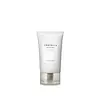What's inside
What's inside
 Key Ingredients
Key Ingredients

 Benefits
Benefits

 Concerns
Concerns

 Ingredients Side-by-side
Ingredients Side-by-side

Water
Skin ConditioningCetearyl Alcohol
EmollientPropanediol
SolventSqualane
EmollientGlycerin
HumectantRubus Idaeus Seed Oil
EmollientTripelargonin
EmollientButyrospermum Parkii Butter
Skin ConditioningAvena Sativa Kernel Oil
Skin ConditioningShea Butter Ethyl Esters
EmollientArachidyl Alcohol
EmollientCentella Asiatica Callus Conditioned Media
Skin ConditioningCetearyl Glucoside
EmulsifyingHydroxyacetophenone
AntioxidantNiacinamide
SmoothingTocopherol
AntioxidantFructose
HumectantUrea
BufferingYeast Extract
Skin ConditioningPhospholipids
Skin ConditioningAllantoin
Skin ConditioningMaltose
MaskingSodium PCA
HumectantTrehalose
Humectant1,2-Hexanediol
Skin ConditioningSphingolipids
EmollientGlucose
HumectantSodium Hyaluronate
HumectantBehenyl Alcohol
EmollientArachidyl Glucoside
EmulsifyingCichorium Intybus Root Extract
MaskingHelianthus Annuus Seed Oil
EmollientPentylene Glycol
Skin ConditioningCitric Acid
BufferingSodium Hydroxide
BufferingSodium Chloride
MaskingSodium Lactate
BufferingCaprylyl Glycol
EmollientSodium Citrate
BufferingP-Anisic Acid
MaskingWater, Cetearyl Alcohol, Propanediol, Squalane, Glycerin, Rubus Idaeus Seed Oil, Tripelargonin, Butyrospermum Parkii Butter, Avena Sativa Kernel Oil, Shea Butter Ethyl Esters, Arachidyl Alcohol, Centella Asiatica Callus Conditioned Media, Cetearyl Glucoside, Hydroxyacetophenone, Niacinamide, Tocopherol, Fructose, Urea, Yeast Extract, Phospholipids, Allantoin, Maltose, Sodium PCA, Trehalose, 1,2-Hexanediol, Sphingolipids, Glucose, Sodium Hyaluronate, Behenyl Alcohol, Arachidyl Glucoside, Cichorium Intybus Root Extract, Helianthus Annuus Seed Oil, Pentylene Glycol, Citric Acid, Sodium Hydroxide, Sodium Chloride, Sodium Lactate, Caprylyl Glycol, Sodium Citrate, P-Anisic Acid
Water
Skin ConditioningGlycerin
HumectantPropanediol
SolventDipropylene Glycol
HumectantCyclopentasiloxane
EmollientCentella Asiatica Extract
Cleansing1,2-Hexanediol
Skin ConditioningCyclohexasiloxane
EmollientTrehalose
HumectantCaprylyl Methicone
Skin ConditioningC12-14 Pareth-12
EmulsifyingCarbomer
Emulsion StabilisingTromethamine
BufferingC30-45 Alkyl Cetearyl Dimethicone Crosspolymer
EmollientAmmonium Acryloyldimethyltaurate/Vp Copolymer
Butylene Glycol
HumectantXanthan Gum
EmulsifyingZingiber Officinale Root Extract
MaskingMentha Piperita Leaf Extract
Skin ConditioningEthylhexylglycerin
Skin ConditioningDipotassium Glycyrrhizate
HumectantTranexamic Acid
AstringentDextrin
AbsorbentTheobroma Cacao Seed Extract
AntioxidantLeuconostoc/Radish Root Ferment Filtrate
AntimicrobialBiosaccharide Gum-1
HumectantDisodium EDTA
Sodium Hyaluronate
HumectantBeta-Glucan
Skin ConditioningHydrogenated Lecithin
EmulsifyingCoptis Chinensis Root Extract
AntioxidantCetearyl Alcohol
EmollientStearic Acid
CleansingCeramide NP
Skin ConditioningCeramide Ng
Skin ConditioningCholesterol
EmollientPhytosphingosine
Skin ConditioningCeramide As
Skin ConditioningCeramide AP
Skin ConditioningCeramide EOP
Skin ConditioningWater, Glycerin, Propanediol, Dipropylene Glycol, Cyclopentasiloxane, Centella Asiatica Extract, 1,2-Hexanediol, Cyclohexasiloxane, Trehalose, Caprylyl Methicone, C12-14 Pareth-12, Carbomer, Tromethamine, C30-45 Alkyl Cetearyl Dimethicone Crosspolymer, Ammonium Acryloyldimethyltaurate/Vp Copolymer, Butylene Glycol, Xanthan Gum, Zingiber Officinale Root Extract, Mentha Piperita Leaf Extract, Ethylhexylglycerin, Dipotassium Glycyrrhizate, Tranexamic Acid, Dextrin, Theobroma Cacao Seed Extract, Leuconostoc/Radish Root Ferment Filtrate, Biosaccharide Gum-1, Disodium EDTA, Sodium Hyaluronate, Beta-Glucan, Hydrogenated Lecithin, Coptis Chinensis Root Extract, Cetearyl Alcohol, Stearic Acid, Ceramide NP, Ceramide Ng, Cholesterol, Phytosphingosine, Ceramide As, Ceramide AP, Ceramide EOP
 Reviews
Reviews

Ingredients Explained
These ingredients are found in both products.
Ingredients higher up in an ingredient list are typically present in a larger amount.
1,2-Hexanediol is a synthetic liquid and another multi-functional powerhouse.
It is a:
- Humectant, drawing moisture into the skin
- Emollient, helping to soften skin
- Solvent, dispersing and stabilizing formulas
- Preservative booster, enhancing the antimicrobial activity of other preservatives
Cetearyl alcohol is a mixture of two fatty alcohols: cetyl alcohol and stearyl alcohol. It is mainly used as an emulsifier. Emulsifiers help prevent the separation of oils and products. Due to its composition, it can also be used to thicken a product or help create foam.
Cetearyl alcohol is an emollient. Emollients help soothe and hydrate the skin by trapping moisture.
Studies show Cetearyl alcohol is non-toxic and non-irritating. The FDA allows products labeled "alcohol-free" to have fatty alcohols.
This ingredient is usually derived from plant oils such as palm, vegetable, or coconut oils. There is debate on whether this ingredient will cause acne.
Due to the fatty acid base, this ingredient may not be Malassezia folliculitis safe.
Learn more about Cetearyl AlcoholGlycerin is already naturally found in your skin. It helps moisturize and protect your skin.
A study from 2016 found glycerin to be more effective as a humectant than AHAs and hyaluronic acid.
As a humectant, it helps the skin stay hydrated by pulling moisture to your skin. The low molecular weight of glycerin allows it to pull moisture into the deeper layers of your skin.
Hydrated skin improves your skin barrier; Your skin barrier helps protect against irritants and bacteria.
Glycerin has also been found to have antimicrobial and antiviral properties. Due to these properties, glycerin is often used in wound and burn treatments.
In cosmetics, glycerin is usually derived from plants such as soybean or palm. However, it can also be sourced from animals, such as tallow or animal fat.
This ingredient is organic, colorless, odorless, and non-toxic.
Glycerin is the name for this ingredient in American English. British English uses Glycerol/Glycerine.
Learn more about GlycerinPropanediol is an all-star ingredient. It softens, hydrates, and smooths the skin.
It’s often used to:
Propanediol is not likely to cause sensitivity and considered safe to use. It is derived from corn or petroleum with a clear color and no scent.
Learn more about PropanediolSodium Hyaluronate is hyaluronic acid's salt form. It is commonly derived from the sodium salt of hyaluronic acid.
Like hyaluronic acid, it is great at holding water and acts as a humectant. This makes it a great skin hydrating ingredient.
Sodium Hyaluronate is naturally occurring in our bodies and is mostly found in eye fluid and joints.
These are some other common types of Hyaluronic Acid:
Learn more about Sodium HyaluronateTrehalose is a disaccharide made of two glucose molecules (glucose is sugar!). Trehalose is used to help moisturize skin. It also has antioxidant properties.
As a humectant, trehalose helps draw moisture from the air to your skin. This helps keep your skin hydrated.
Due to its antioxidant properties, trehalose may help with signs of aging. Antioxidants help fight free-radical molecules, unstable molecules that may damage your skin.
In medicine, trehalose and hyaluronic acid are used to help treat dry eyes.
Some animals, plants, and bacteria create trehalose as a source of energy to survive freeze or lack of water.
Learn more about TrehaloseWater. It's the most common cosmetic ingredient of all. You'll usually see it at the top of ingredient lists, meaning that it makes up the largest part of the product.
So why is it so popular? Water most often acts as a solvent - this means that it helps dissolve other ingredients into the formulation.
You'll also recognize water as that liquid we all need to stay alive. If you see this, drink a glass of water. Stay hydrated!
Learn more about Water